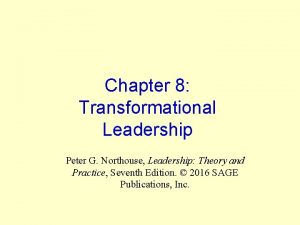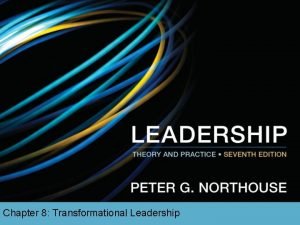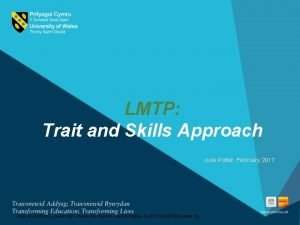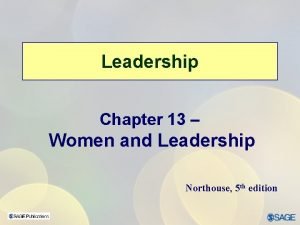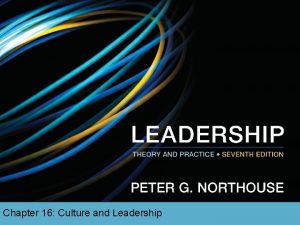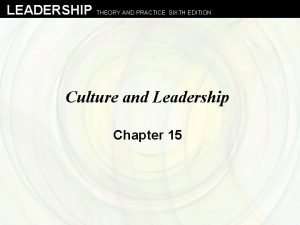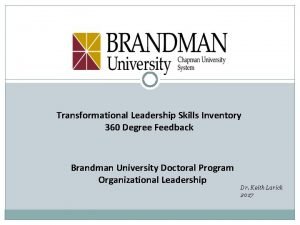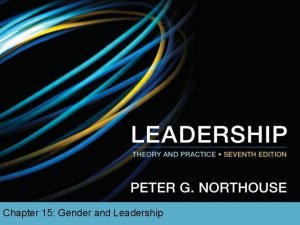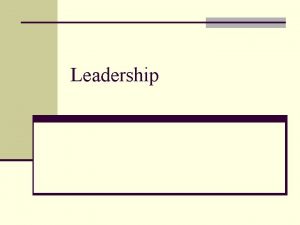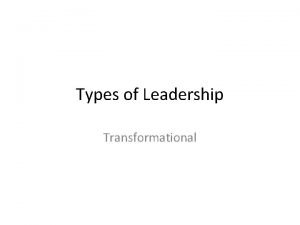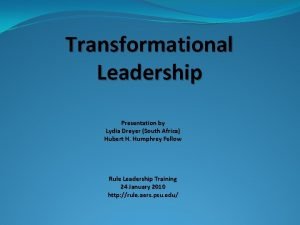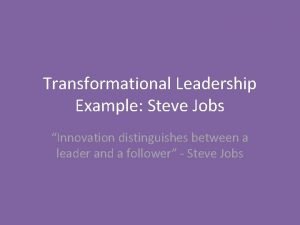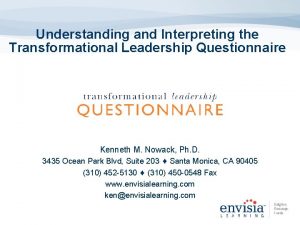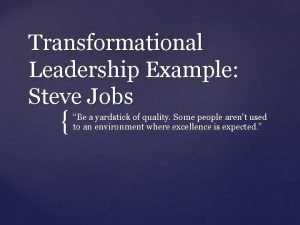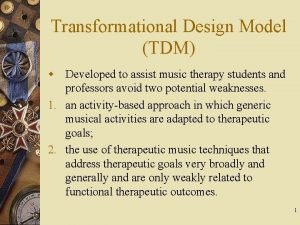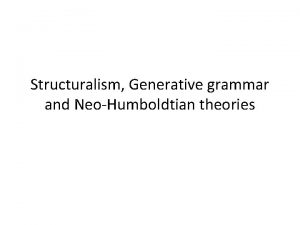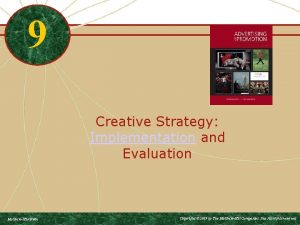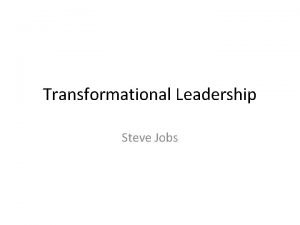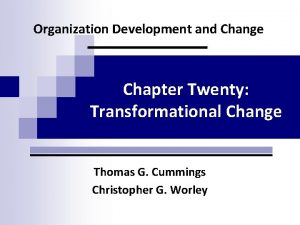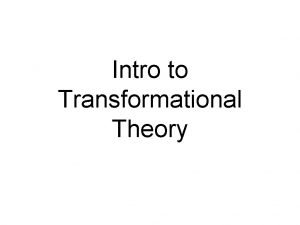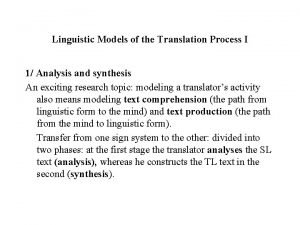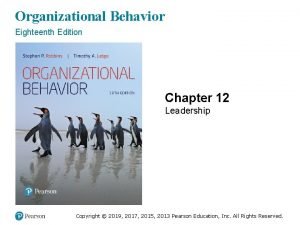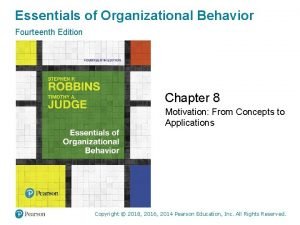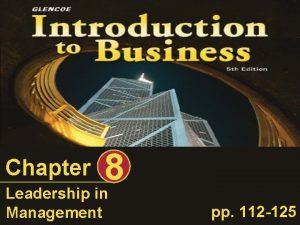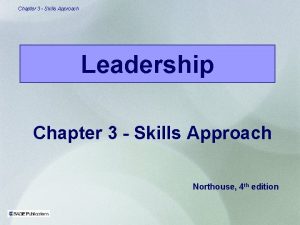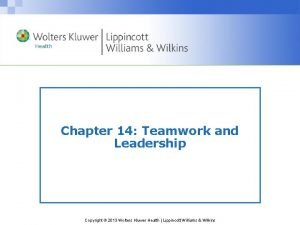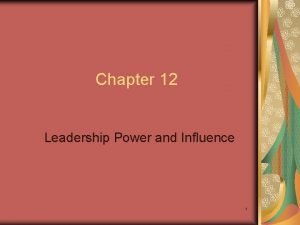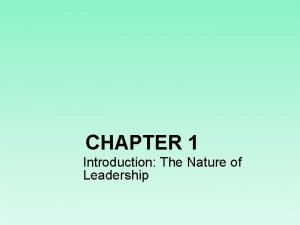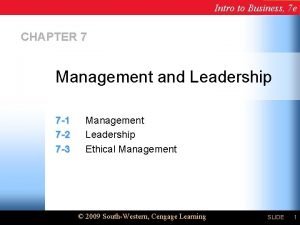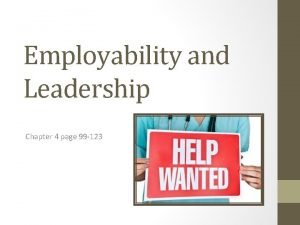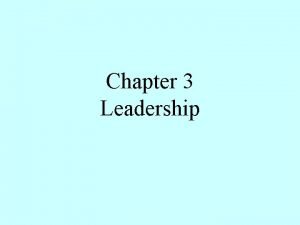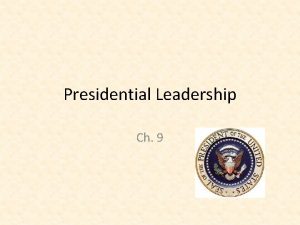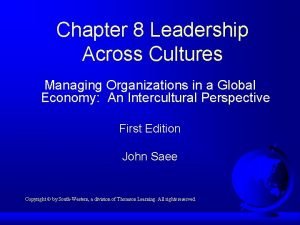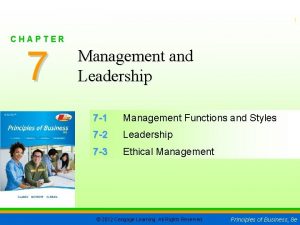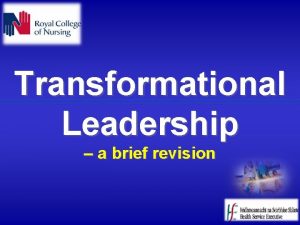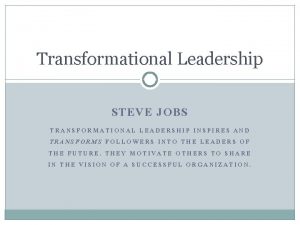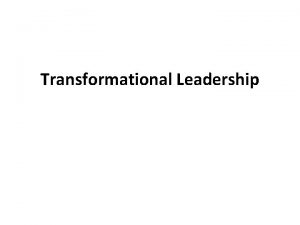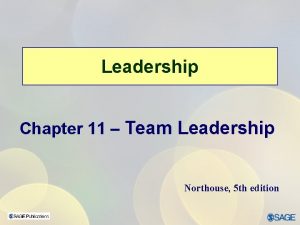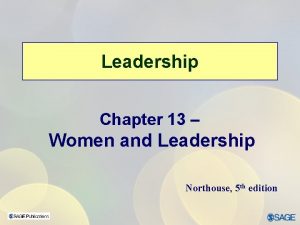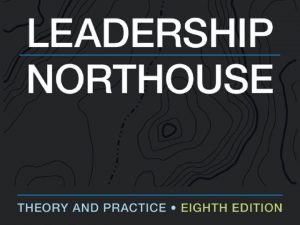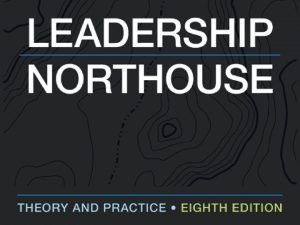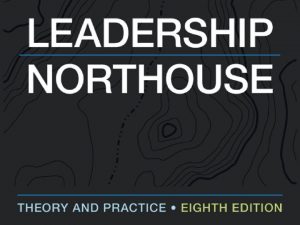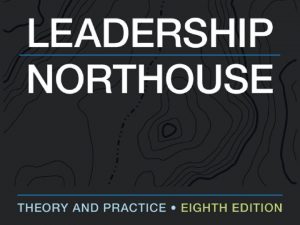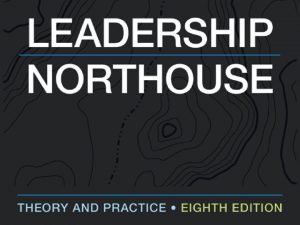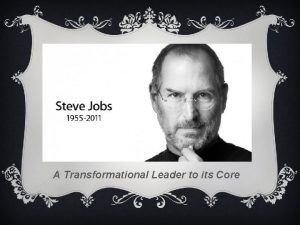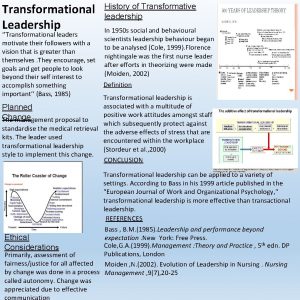Chapter 8 Transformational Leadership Peter G Northouse Leadership



































































- Slides: 67

Chapter 8: Transformational Leadership Peter G. Northouse, Leadership: Theory and Practice, Seventh Edition. © 2016 SAGE Publications, Inc.

Overview ÷ Transformational Leadership (TL) Perspective ÷ A Model of Transformational Leadership ÷ Transformational Leadership Factors ÷ Full Range of Leadership Model ÷ The Additive Effects of TL ÷ Other Transformational Leadership Perspectives ÷ How Does the Transformational Approach Work?

Transformational Leadership Description ÷ Process - TL is a process that changes and transforms individuals ÷ Influence - TL involves an exceptional form of influence that moves followers to accomplish more than what is usually expected ÷ Core elements - TL is concerned with emotions, values, ethics, standards, and long-term goals ÷ Encompassing approach – TL describes a wide range of leadership influence where followers and leaders are bound together in the transformation process

Types of Leadership Defined (Burns, 1978) TRANSACTIONAL Focuses on the exchanges that occur between leaders and their followers PSEUDOTRANSFORMATIONAL Process of engaging with others to create a connection that increases motivation and morality in both the leader and the follower Focuses on the leader’s own interests rather than the interests of his or her followers

Types of Leadership Defined (Burns, 1978) - No new taxes = votes. - Turn in assignments = grade. - Surpass goals = promotion. The exchange dimension is so common that you can observe it at all walks of life. Focuses on the exchanges that occur between leaders and their followers TRANSACTIONAL

Types of Leadership Defined (Burns, 1978) ÷Leaders who are ® transforming but in a negative way ® self-consumed, exploitive; poweroriented, with warped moral values ÷includes leaders like ® Adolph Hitler ® Saddam Hussein ÷Focuses on the leader’s own interests rather than the interests of his or her followers PSEUDOTRANSFORMATIONAL

Pseudotransformational (Christie, Barling, & Turner, 2011) ÷ Four experimental studies => model of pseudotransformational leadership 1) Self-serving 2) Unwilling to encourage independent thought in followers 3) Exhibits little general caring for others 4) Uses inspiration and appeal to manipulate followers for his or her own ends

Types of Leadership Defined Burns (1978) v. Leader is attentive to the needs and motives of followers and tries to help followers reach their fullest potential. • Mohandas Gandhi raised the hopes and demands of millions of his people and in the process was changed himself • Ryan White raised people’s awareness about AIDS Process of engaging with others to create a connection that increases motivation and morality in both the leader and the follower TRANSFORMATIONAL

Transformational Leadership & Charisma Definition ÷ Charisma - A special personality characteristic that gives a person superhuman or exceptional powers and is reserved for a few, is of divine origin, and results in the person being treated as a leader (Weber, 1947) ÷ Charismatic Leadership Theory (House, 1976) ® Charismatic leaders act in unique ways that have specific charismatic effects on their followers

Theory of Charismatic Leadership (House, 1976)

Theory of Charismatic Leadership (Shamir, House, & Arthur, 1993) Later Studies ÷ Charismatic Leadership – ® Transforms follower’s self-concepts; tries to link identity of followers to collective identity of the organization • Forge this link by emphasizing intrinsic rewards & de -emphasizing extrinsic rewards • Throughout process, leaders Express high expectations for followers § help followers gain sense of self-confidence and selfefficacy §

Model of Transformational Leadership (Bass, 1985) ®Expanded and refined version of work done by Burns and House. It included • More attention to followers’ rather than leader’s needs • Suggested TL could apply to outcomes that were not positive • Described transactional and transformational leadership as a continuum ® Extended House’s work by • Giving more attention to emotional elements & origins of charisma • Suggested charisma is a necessary but not sufficient condition for TL

TL motivates followers beyond the expected by § raising consciousness about the value and importance of specific and idealized goals § transcending self-interest for the good of the team or organization § addressing higher-level needs

Transformational Leadership Factors

Full Range of Leadership Model

Transformational Leadership Factors: The 4 Is ÷ Idealized Influence ® Acting as strong role models ® High standards of moral and ethical conduct ® Making others want to follow the leader’s vision ÷ Inspirational Motivation ® Communicating high expectations ® Inspiring followers to commitment and engagement in shared vision ® Using symbols & emotional appeals to focus group members to achieve more than self-interest

Transformational Leadership Factors: The 4 Is ÷ Intellectual Stimulation ® Stimulating followers to be creative and innovative ® Challenging their own beliefs and valuing those of leader and organization ® Supporting followers to ® Try new approaches ® Develop innovative ways of dealing with organization issues ÷ Individualized Consideration ® ® Listening carefully to the needs of followers Acting as coaches to assist followers in becoming fully actualized Helping followers grow through personal challenges Ex. Showing optimism helps employees become more engaged in their work (Tims et al. , 2011)

Transactional Leadership Factors Contingent Reward The exchange process between leaders and followers in which effort by followers is exchanged for specified rewards Management-by-Exception Leadership that involves corrective criticism, negative feedback, and negative reinforcement ®Two forms • Active - Watches follower closely to identify mistakes/rule violations • Passive - Intervenes only after standards have not been met or problems have arisen

Nonleadership Factor Laissez-Faire The Absence of Leadership ÷A hands-off, let-things-ride approach ÷Refers to a leader who ®abdicates responsibility ®delays decisions ®gives no feedback, and ®makes little effort to help followers satisfy their needs


Bennis & Nanus (1985) Four Leader Strategies in Transforming Organizations ÷ Clear vision of organization’s future state ÷ TL’s social architect of organization ÷ Create trust by making their position known and standing by it ÷ Creatively deploy themselves through positive self-regard

Kouzes & Pozner (1987, 2002) Model consists of five fundamental practices ÷ Model the Way ÷ Inspire a Shared Vision ÷ Challenge the Process ÷ Enable Others to Act ÷ Encourage the Heart

How Does the Transformational Leadership Approach Work? ÷ Focus of Transformational Leadership ÷ Strengths ÷ Criticisms ÷ Application

Transformational Leadership Overall Scope ÷ Describes how leaders can initiate, develop, and carry out significant changes in organizations Focus of Transformational Leaders ÷ TLs empower and nurture ÷ ÷ followers TLs stimulate change by becoming strong role models for followers TLs commonly create a vision TLs require leaders to become social architects TLs build trust & foster collaboration

Strengths ÷ Broadly researched. TL has been widely researched, including a large ÷ ÷ ÷ body of qualitative research centering on prominent leaders and CEOs in major firms. Intuitive appeal. People are attracted to TL because it makes sense to them. Process focused. TL treats leadership as a process occurring between followers and leaders. Expansive leadership view. TL provides a broader view of leadership that augments other leadership models. Emphasizes followers. TL emphasizes followers’ needs, values, and morals. Effectiveness. Evidence supports that TL is an effective form of leadership.

Criticisms ÷ Lacks conceptual clarity ® Dimensions are not clearly delimited ® Parameters of TL overlap with similar conceptualizations of leadership ÷ Measurement questioned ® Validity of MLQ not fully established ® Some transformational factors are not unique solely to the transformational model ÷ TL treats leadership more as a personality trait or predisposition than a ÷ ÷ behavior that can be taught No causal link shown between transformational leaders and changes in followers or organizations TL is elitist and antidemocratic Suffers from heroic leadership bias Has the potential to be abused

Application ÷ Provides a general way of thinking about leadership that ÷ ÷ ÷ stresses ideals, inspiration, innovations, and individual concerns Can be taught to individuals at all levels of the organization Able to positively impact a firm’s performance May be used as a tool in recruitment, selection, promotion, and training development Can be used to improve team development, decisionmaking groups, quality initiatives, and reorganizations The MLQ and Sosik and Jung (2010) guide help leaders to target areas of leadership improvement

Chapter 9: Authentic Leadership Peter G. Northouse, Leadership: Theory and Practice, Seventh Edition. © 2016 SAGE Publications, Inc.

Overview ÷ Authentic Leadership Description ÷ Authentic Leadership Defined ÷ Approaches to Authentic Leadership ÷ Practical ÷ Theoretical ÷ How does Authentic Leadership Theory Work?

Authentic Leadership Description ÷ Authentic Leadership – focuses on whether leadership is genuine ÷ Interest in Authentic Leadership ® Increasing in recent times due to social upheavals ® People longing for trustworthy leaders ® Identified earlier in transformational leadership research but not studied separately ® Needed evidence-based research of construct

Authentic Leadership Defined ÷ Intrapersonal Definition: ® Leadership based on self-concept and how self-concept relates to actions (Shamir & Eilam, 2005) ® Relies on the life story of the leader ÷ Three Authentic Leadership Characteristics: ® ALs exhibit genuine leadership ® ALs lead from conviction ® ALs are originals, not copies

Authentic Leadership Defined ÷ Interpersonal Definition: ® Leadership is created by leaders and followers together (Eagly, 2005) ® It is a reciprocal process because leaders affect followers and followers affect leaders

Authentic Leadership Defined ÷ Developmental Definition: ® Leadership can be nurtured and developed over a lifetime (Avolio & Gardner, 2005) ® Can be triggered by major life events ® Leader behavior is grounded in positive psychological qualities and strong ethics ÷ Four authentic leadership components: ® Self-awareness ® Internalized moral perspective ® Balanced processing ® Relational transparency

Practical Approaches to Authentic Leadership ÷ Bill George (2003, 2007) ® Leader characteristic model ® Leaders have genuine desire to serve others ® Five characteristics of authentic leaders • Understand their purpose • Strong values • Trusting relationships • Self-discipline • Act from the heart (mission)


Theoretical Approaches to Authentic Leadership Recent Research Spurred By ÷ Leadership summit publications (2005) ÷ Social upheaval and desire for leadership that serves the common good ÷ Need to explore meaning of authentic leadership and create theoretical framework ÷ Need to define the construct of authentic leadership

Definition of Authentic Leadership “A pattern that draws upon and promotes both positive psychological capacities and a positive ethical climate, to foster greater self-awareness, an internalized moral perspective, balanced processing of information, and relational transparency on the part of leaders working with followers, fostering positive self-development. ” -Walumbwa, Avolio, Gardner, Wernsing, & Peterson, 2008

Basic Model of Authentic Leadership FOUR COMPONENTS ÷ Self-awareness ® Reflecting on one’s core values, identity, emotions, motives ® Being aware of and trusting one’s own feelings ÷ Internalized moral perspective ® Self-regulatory process using internal moral standards to guide behavior ÷ Balanced processing ® Ability to analyze information objectively and explore other people’s opinions before making a decision ÷ Relational transparency ® Being open and honest in presenting one’s true self to others

Factors That Influence Authentic Leadership ÷ Positive psychological capacities ®Confidence ®Hope ®Optimism ®Resilience ÷ Moral Reasoning Capacities ® Deciding right and wrong ® Promoting justice, greater good of the organization or community

Factors That Influence Authentic Leadership Critical Life Events - Positive or negative ÷ Act as a catalyst for change ÷ People attach insights to their life experiences ÷ When people tell life stories they gain clarity about who they are ÷ Stimulate personal growth

How Does Authentic Leadership Theory Work? ÷ Strengths ÷ Criticisms ÷ Application

How Does Authentic Leadership Theory Work? ÷ AL is a complex, developmental process ÷ The practical approaches are prescriptive: ® George (2003) – Five characteristics leaders need to be authentic ÷ Theoretical approach describes what accounts for AL: ® Four attributes ® Attributes developed over lifetime, often through critical events

Strengths ÷ Fulfills society’s expressed need for trustworthy leadership. Fills a void in an uncertain world. ÷ Provides broad guidelines for those who want to become authentic leaders. Both practical and theoretical approaches provide a map. ÷ Like transformational and servant leadership, AL has an explicit moral dimension. ÷ Unlike traits that only some people exhibit, everyone can learn to be more authentic. ÷ Can be measured using an established instrument (ALQ).

Criticisms ÷ The theory is still in the formative stages, so some concepts in the practical approaches are not fully developed or substantiated. ÷ The moral component of AL is not fully explained. It’s unclear how higher values such as justice inform authentic leadership. ÷ The rationale for including positive psychological capacities as a part of AL has not been clearly explained by researchers. ÷ The link between authentic leadership and positive organizational outcomes is unclear. It is also not clear whether AL is sufficient to achieve organizational goals.

Application ÷ People have the capacity to become authentic leaders. It is a lifelong learning process. ÷ Human resource departments may be able to foster authentic leadership behaviors in employees who move into leadership positions. ÷ Leaders are always trying to do the “right” thing, to be honest with themselves and others, and to work for the common good. ÷ Leaders are shaped by critical life events that lead to growth and greater authenticity.

Chapter 10: Servant Leadership Peter G. Northouse, Leadership: Theory and Practice, Seventh Edition. © 2016 SAGE Publications, Inc.

Overview ÷ Servant Leadership Description ÷ Servant Leadership Defined ÷ Historical Basis of Servant Leadership ÷ Ten Characteristics of Servant Leadership ÷ Building a Theory about Servant Leadership

Overview ÷Building a Model of Servant Leadership ÷How Does Servant Leadership Work? ÷Strengths and Criticisms ÷Application

Servant Leadership Description ÷ Servant Leadership – is a paradox: both service and influence ÷ Interest in Servant Leadership ® Most scholarship has been prescriptive, until recently ® Past 10 years have clarified the concept and its assumptions ® Focuses on leadership from the point of view of the leader and his/her behaviors ® Servant leaders put followers first

Servant Leadership Defined ÷ Greenleaf Definition: “Servant leadership begins with the natural feeling that one wants to serve, to serve first. Then conscious choice brings one to aspire to lead. . The difference manifests itself in the care taken by the servant—first to make sure that other people’s highest priority needs are being served. The best test. . . is: do those served grow as persons; do they, while being served, become healthier, wiser, freer, more autonomous, more likely themselves to become a servant? And, what is the effect on the least privileged in society; will they benefit, or, at least, will they not be further deprived? ” Sometimes treated as a trait, but viewed as a behavior in this chapter

Historical Basis of Servant Leadership ÷ Greenleaf Center for Servant Leadership ® Advocating for building consensus in groups rather than using coercive leadership ® Inspired by Hesse’s novel, Journey to the East, where the travelers discovered the true leader of their group was the servant ® Leaders have a social responsibility for the “have-nots” ® Leaders shift authority to those who are being led

10 Characteristics of a Servant Leader (Spears, 2002) 1. Listening - acknowledging the viewpoint of followers and validating these perspectives. 2. Empathy – “standing in the shoes” of another person and attempting to see the world from that person’s point of view. 3. Healing – in helping followers become whole, servant leaders are themselves healed. 4. Awareness – understanding oneself and the impact one has on others.

10 Characteristics of a Servant Leader (Spears, 2002) 5. Persuasion – creates change through gentle, nonjudgmental argument. 6. Conceptualization – the ability to be a visionary for an organization. 7. Foresight – the ability to predict what is coming based on what is occurring in the present and what has happened in the past.

10 Characteristics of a Servant Leader (Spears, 2002) 8. Stewardship – carefully managing the people and organization one has been given to lead. Holding the organization in trust for the greater good of society. 9. Commitment to the Growth of People – treating each follower as a unique person with intrinsic value beyond what he/she contributes to the organization. 10. Building Community – allowing followers to identify with something greater than themselves that they value.

Building a Theory about Servant Leadership ÷ Greenleaf’s leadership approach – loosely defined characteristics and normative principles ÷ Servant leadership adopted as guiding philosophy in many organizations ÷ Recent models of Servant Leadership developed using multiple variables ® Russell and Stone (2002) ® Patterson (2003)


SOURCE: Adapted from Liden, R. C. , Panaccio, A. , Hu, J. , & Meuser, J. D. (2014). Servant leadership: Antecedents, consequences, and contextual moderators. In D. V. Day (Ed. ), The Oxford handbook of leadership and organizations. Oxford, England: Oxford University Press; and van Dierendonck, D. (2011). Servant leadership: A review and syntheses. Journal of Management, 37(4), 1228– 1261.

Model of Servant Leadership (Liden et al. , 2008) ÷ Antecedent Conditions (3) ® Context and culture • Organizational context • Dimensions of culture (e. g. , power distance) ® Leader attributes • Traits interact with ability to engage in servant leadership (e. g. , moral development, emotional intelligence) ® Follower receptivity • Some subordinates do not want to work with servant leaders • When matched with followers who desire it, servant leadership has a positive impact on performance and organizational citizenship behavior

Model of Servant Leadership (Liden et al. , 2008) ÷ Servant Leader Behaviors (7) ® Conceptualizing • Thorough understanding of the organization • Ex. Senior nursing supervisor in emergency room ® Emotional healing • Recognizing others’ problems and taking the time to address them • Ex. Hospice priest on Chicago’s south side ® Putting followers first • Ex. Widely published health education professor

Model of Servant Leadership (Liden et al. , 2008) ® Helping followers grow and succeed • Knowing followers’ professional or personal goals • Ex. High school music teacher ® Behaving ethically • Doing the right thing in the right way • Ex. CEO and leaked document from rival company ® Empowering • Allowing followers the freedom to be independent, make decisions on their own, and be self-sufficient • Ex. College professor with TAs

Model of Servant Leadership (Liden et al. , 2008) ®Creating value for the community • Intentionally giving back to the community • Encouraging followers to volunteer for community service • Ex. Principal of alternative high school

Model of Servant Leadership (Liden et al. , 2008) ÷ Outcomes (3) - Follower performance and growth • Recognizing followers’ contributions and helping them realize their human potential • Favorable impact on subordinate in-role performance • Followers themselves may become servant leaders - Organizational performance • Positive relationship between servant leadership and OCB • Team effectiveness enhanced by increasing members’ shared confidence that they could be effective - Societal impact • Ex. Mother Teresa and Sisters of Charity • Ex. Southwest Airlines

How Does Servant Leadership Work? ÷ Servant Leadership is different from many other leadership theories. ÷ It is concerned with putting followers first and the outcomes that are likely to emerge. ÷ Servant Leadership works best when leaders are altruistic and have a strong motivation to help others. ÷ It is important for followers to be receptive to this style of leadership. ÷ Servant Leadership results in community and societal change.

Strengths ÷ Makes altruism the central component of the leadership process. ÷ Provides a counterintuitive approach to the use of influence. Leaders should share control. ÷ Servant Leadership is not a panacea. It may not be effective when subordinates are not open to being guided, supported, and empowered. ÷ Research has resulted in a sound measure of Servant Leadership— the SLQ.

Criticisms ÷ Because the name appears contradictory, Servant Leadership may be seen as whimsical, or not really “leadership. ” ÷ Researchers are unable to reach consensus on a common definition or theoretical framework for Servant Leadership. ÷ The prescriptive overtone suggests that good leaders “put others first, ” which conflicts with other principles of leadership such as directing, concern for production, and so on. It can also sound moralistic, which may deter some researchers. ÷ Conceptualizing is not unique to servant leaders. It is unclear why it is included in this model.

Application ÷ Servant Leadership can be applied at all levels of management and in all types of organizations. ÷ Servant Leadership has been used extensively in a variety of organizations for more than 30 years. ÷ Organizations should be careful to select employees who (a) are interested in building long-term relationships with followers and (b) have strong ethics. ÷ Servant Leadership is taught at many colleges and universities and is used by numerous independent coaches, trainers, and consultants.

Queen Elizabeth II sees herself as a servant leader ÷ Littrell, Chapter 8, “Cultural Mythology and Global Leadership in England”
 Peter northouse leadership
Peter northouse leadership Transformational leadership northouse chapter 8
Transformational leadership northouse chapter 8 Servant theory
Servant theory Peter northouse
Peter northouse Transactional vs transformational
Transactional vs transformational Leadership labyrinth northouse
Leadership labyrinth northouse Culture and leadership northouse
Culture and leadership northouse Servant leadership northouse
Servant leadership northouse Culture and leadership northouse
Culture and leadership northouse Inventory360
Inventory360 Leadership labyrinth northouse
Leadership labyrinth northouse Transformational leadership kouzes and posner
Transformational leadership kouzes and posner Steve jobs intellectual stimulation
Steve jobs intellectual stimulation Steve jobs transformational leadership style
Steve jobs transformational leadership style Smooth running
Smooth running Transformational leadership factors the 4 i's
Transformational leadership factors the 4 i's Howard schultz transformational leadership
Howard schultz transformational leadership Howard schultz transformational leadership
Howard schultz transformational leadership Transformational synonym
Transformational synonym Transformational leadership presentation
Transformational leadership presentation Steve jobs as a transformational leader
Steve jobs as a transformational leader Transformational leadership questionnaire (tlq)
Transformational leadership questionnaire (tlq) Idealized influence
Idealized influence Four i's of transformational leadership
Four i's of transformational leadership Steve jobs as transformational leader
Steve jobs as transformational leader Transformational leadership
Transformational leadership Transcendent leadership vs transformational
Transcendent leadership vs transformational Steps for transformational leadership
Steps for transformational leadership Gandhi transformational leadership
Gandhi transformational leadership Was steve jobs a transformational leader
Was steve jobs a transformational leader Transactional leadership
Transactional leadership Leadership ki paribhasha
Leadership ki paribhasha Tdm model
Tdm model Transformational change model
Transformational change model Structuralism grammar
Structuralism grammar Generative grammar
Generative grammar Deep and surface structure examples
Deep and surface structure examples Creative strategy implementation and evaluation
Creative strategy implementation and evaluation Steve jobs transformational leader
Steve jobs transformational leader Dfs inc flex plan
Dfs inc flex plan Mays transformational leader mindsets
Mays transformational leader mindsets The heart of coaching
The heart of coaching Steve jobs transformational leader
Steve jobs transformational leader Characteristics of transformational change
Characteristics of transformational change Transformational theory music
Transformational theory music Transformational advertising
Transformational advertising Model of translation process
Model of translation process Adaptive leadership style
Adaptive leadership style Enthusiastic beginner disillusioned learner
Enthusiastic beginner disillusioned learner Chapter 12 leadership organizational behavior
Chapter 12 leadership organizational behavior Lord of the flies chapter 8 summary
Lord of the flies chapter 8 summary Chapter 8 organizational leadership
Chapter 8 organizational leadership Chapter 8 leadership in management
Chapter 8 leadership in management Chapter 7 leadership
Chapter 7 leadership Leadership skills are defined in the chapter as
Leadership skills are defined in the chapter as Chapter 14 teamwork and leadership
Chapter 14 teamwork and leadership Chapter 12 leadership
Chapter 12 leadership Leadership chapter 1
Leadership chapter 1 Intro to business chapter 7 study guide
Intro to business chapter 7 study guide Chapter 4 employability and leadership
Chapter 4 employability and leadership Chapter 4 employability and leadership
Chapter 4 employability and leadership Leadership style speech
Leadership style speech Chapter 15 leadership
Chapter 15 leadership Congress informal powers
Congress informal powers Chapter 8 leadership in management
Chapter 8 leadership in management Chapter 7 management and leadership
Chapter 7 management and leadership Hans peter scharl
Hans peter scharl Peter brooks what is a monster
Peter brooks what is a monster
